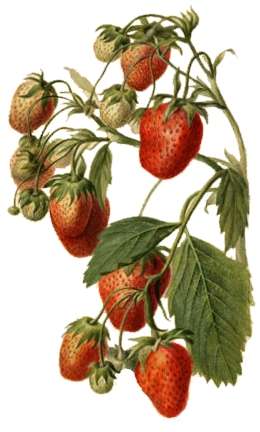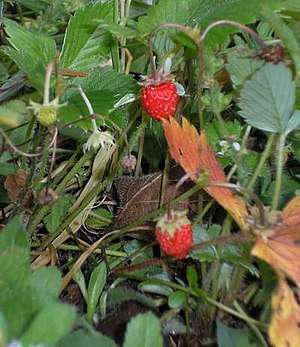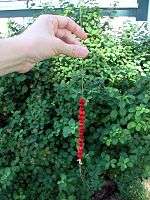| Strawberries | |
|---|---|
 | |
| Genus: | Fragaria |
| Family: | Rosaceae |
| Type: | Perennials |
| Transplant: | Transplanted easily |
| Pest issues: | Some serious |
| Root: | Rhizomes, spreading by stolons. |
| Toxicity and edibility: | Fruits are edible, most are sweet. |
The strawberry (Fragaria) is a genus of plants in the family Rosaceae, and the fruit of these plants. There are more than 20 named species and many hybrids and cultivars. The most common strawberries grown commercially are cultivars of the Garden strawberry, Fragaria x ananassa.
The typical modern strawberry grown as a food crop comes from the Americas, and is a hybrid of both north and South American varieties. Ironically, the crossbreeding was done in Europe to correct a mistake; the European horticulturists had only brought female South American plants, and were forced to cross them with the North American variety in order to get fruit and seeds.
Fragaria comes from "fragans", meaning odorous, an allusion to the perfumed flesh of the fruit. Madam Tallien, a great figure of the French Revolution, who was nicknamed Our Lady of Thermidor, used to take baths full of strawberries to keep the full radiance of her skin. Fontenelle, centenarian writer and gourmet of the 18th century, considered his long life was due to the strawberries he used to eat.
Description
The strawberry is an accessory fruit, meaning that the fleshy part is derived not from the ovaries (which are the "seeds", or achenes) but from the peg at the bottom of the hypanthium that held the ovaries. So from a technical standpoint, the seeds are the actual fruits of the plant, and the flesh of the strawberry is modified receptacle tissue. It is greenish-white as it develops and in most species turns red when ripe.
Growing Conditions
Varieties
There are more than 20 different Fragaria species worldwide. Key to the classification of strawberry species is recognizing that they vary in the number of chromosomes. There are seven basic types of chromosomes that they all have in common. However, they exhibit different polyploidy. Some species are diploid, having two sets of the seven chromosomes (14 chromosomes total). Others are tetraploid (four sets, 28 chromosomes total), hexaploid (six sets, 42 chromosomes total), octoploid (eight sets, 56 chromosomes total), or decaploid (ten sets, 70 chromosomes total).
As a rough rule (with exceptions), strawberry species with more chromosomes tend to be more robust and produce larger plants with larger berries (Darrow).
- Diploid species

- Fragaria daltoniana
- Fragaria iinumae
- Fragaria nilgerrensis
- Fragaria nipponica
- Fragaria nubicola
- Fragaria vesca (Woodland Strawberry)
- Fragaria viridis
- Fragaria yezoensis
- Tetraploid species
- Fragaria moupinensis
- Fragaria orientalis
- Hexaploid species
- Fragaria moschata (Musk Strawberry)
- Octoploid species and hybrids
- Fragaria x ananassa (Garden Strawberry)
- Fragaria chiloensis (Beach Strawberry)
- Fragaria iturupensis (Iturup Strawberry)
- Fragaria virginiana (Virginia Strawberry)
- Decaploid species and hybrids
- Fragaria × Potentilla hybrids
- Fragaria × vescana
Numerous other species have been proposed. Some are now recognized as subspecies of one of the above species (see GRIN taxonomy database).
The Mock Strawberry and Barren Strawberry, which both bear resemblance to Fragaria, are closely related species in the genus Potentilla. The Strawberry tree is an unrelated species.
Uses
Maintenance
Propagation
Harvest
Pests and Diseases
Gray Mold
White Mold
- Sclerotinia
Nutrient Deficiencies
- Boron Deficiency
- Melon Aphid: Aphis gossypii
- Buckthorn Aphid: Aphis nasturtii
- Strawberry Aphid: Chaetosiphon fragaefolii
Spittlebugs
- Meadow Spittlebug: Philaenus spumarius
- Tarnished Plant Bug: Lygus lineolaris
- European Earwig: Forficula auricularia
- Western Flower Thrips: Frankliniella occidentalis
- Fuller Rose Beetle: Pantomorus cervinus
- Fourspotted Sap Beetle: Glischrochilus quadrisignatus
- Hop Flea Beetle: Psyllioides punctata
- Palestriped Flea Beetle: Systena blanda
- Redheaded Flea Beetle: Systena frontalis
- Strawberry Flea Beetle: Altica ignata
- Strawberry Rootworm: Paria fragariae
- Strawberry Sap Beetle: Stelidota geminata
- Rough Strawberry Root Weevil: Brachyrhinus rugostriatus
- Strawberry Root Weevil: Otiorhynchus ovatus
- Strawberry Bud Weevil: Anthonomus signatus
- Strawberry Leafroller: Ancylis comptana fragariae
- Obliquebanded Leafroller: Choristoneura rosaceana
- Stalk Borer: Papaipema nebris
- Sparganothis Leafroller: Sparganothis sulfureana
- Green Fruitworm: Lithophane antennata
- Omnivorous Leaftier: Cnephasia longana
- Redbanded Leafroller: Platymota stultana
- Strawberry Crown Borer: Synanthedon bibionipennis
- Strawberry Crownminer: Monochroa fragariae
- Variegated Leafroller: Platynota flavedana
- Cyclamen Mite: Steneotarsonemus pallidus
Millipedes
Slugs and Snails
Gallery
 Closeup of the surface of a strawberry
Closeup of the surface of a strawberry Strawberry flowers and developing fruit
Strawberry flowers and developing fruit Harvested strawberries
Harvested strawberries The traditional North European way of gathering strawberries
The traditional North European way of gathering strawberries- A wild strawberry plant, showing characteristic shape
- Strawberry farms generally add hives of honeybees to improve pollination
- A large strawberry.
- Strawberry farm in DaHu, Taiwan
References
- Ann Fowler Rhoads and Timothy A. Block (2000). The Plants of Pennsylvania: An Illustrated Manual. Anna Anisko, illustrator. Morris Arboretum, University of Pennsylvania Press. pp. 605–606.
- P. D. Strausbaugh and Earl L. Core (1977). Flora of West Virginia (Second ed.). Seneca Books, Grantsville, W. Virginia. pp. 490–493.
- Christopher Brickell and Judith D. Zuk (1997). The American Horticultural Society A-Z Encyclopedia of Garden Plants. DK Publishing. pp. 443.
- Staff of the L. H. Bailey Hortorium (1976). Hortus Third: A Concise Dictionary of Plants Cultivated in the United States and Canada. Cornell University Press. pp. 484.
- Cranshaw, Whitney (2004). Garden Insects of North America: The Ultimate Guide to Backyard Bugs. Princeton University Press. pp. 596.
- Pippa Greenwood, Andrew Halstead, A.R. Chase, Daniel Gilrein (2000). American Horticultural Society Pests & Diseases: The Complete Guide to Preventing, Identifying, and Treating Plant Problems (First Edition ed.). Dorling Kindersley (DK) Publishing, inc.. pp. 205.
- Darrow, George M. The Strawberry: History, Breeding and Physiology. New York. Holt, Rinehart and Winston, 1966. Available online.
- List of Fragaria resources, USDA
- GRIN Fragaria Taxonomy Database Listing of Fragaria species, also from a USDA website
- Medicinal uses of strawberries in Armenia
- Fragaria chiloensis pictures from Chilebosque
- Strawberry pest management guidelines
- Crossing of cv. 'Mieze Schindler' with cv. 'Elsanta'